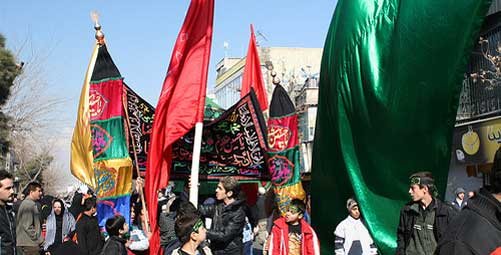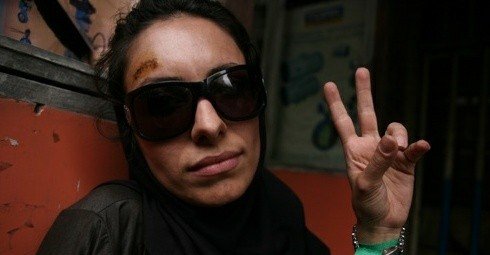A natural grassroots' alliance has been established between groups of leftist students and liberal Shiite clerics on the streets of Iranian cities during least year's popular uprisings. In an apparent attempt to break up this alliance, parliament spokesman Ali Larijani recently urged "those whom we know as leftists groups within the Islamic regime to distance themselves from counter-revolutionary demonstrators." (Iran Labor News Agency, January 2, 2010). But, what was considered as Islamic and revolutionary in 1979, is today a total anachronism of isolationist counter revolution in the eyes of the Iranian left. Therefore, Larijani is actually asking the new revolutionary left to join the counter-revolutionaries within the Islamic regime! Larijani is desperately trying to flirt with the leftist streams within the Iranian labor movement. Will he succeed? Will the elite of the labor movement allow non-labor interests to seduce it again, that is, for the third time?!
The relationship between the Iranian Left, on the one side, and the nationalists and the Shiite clergy, on the other, is a 100-years-old story of love and hate. The ideas of the European labor movement were introduced to the constitutionalist movement (Mashrouteh) in Iran at the beginning of the 20th century. In the beginning, the intellectual leftist movement was largely influenced by the Caucasian branches of the Russian Social-Democratic and later on the Bolshevik party. Early social-democratic groups and the following Iranian Communist and Tudeh parties were elite movements trying to counter-balance the growing influence of the Shiite clergy, privileged groups, and their colonial allies within the constitutionalist movement. At the end of the Second World War, the Dulles doctrine of an Islamic green belt between the Soviet Union and its southern neighbors resulted in three decades of balanced coexistence between the Phalavi aristocracy and the Shiite theocracy; the former in control of the actual power based on increasing oil revenues, the latter a potential power through its unchallenged spiritual bonds with people organized around several independent grand ayatollahs. Anti-royalist secular groups, including the orthodox pro-Soviet left led by Tudeh Party and the nationalists under the National Front and Mohammad Mosaddegh, lost the battle of power mainly because they only represented isolated social elite such as communists and nationalists, whereas the majority of people were poor or religious, or rather poor and thereby religious! These masses were represented by more than 50.000 full-time professional mullahs belonging to several totally independent hierarchic religious organizations resembling the Vatican state.
This balanced coexistence between the religious institution and monarchy was disturbed and consequently broken when Mohammad-Reza Shah, confident of his growing economic power based on oil revenues, challenged the Shiite clergy on social structures issues such as history and culture. He allowed ultra-nationalist, racist, and even anti-Shiite individuals and groups such as Pezeshk-Pour's Pan-Iranist group, Bahaii activists, and Fahgang Mehr's Zoroastrian theologs to draw a new road map for the new Iran. These elements managed to convince him to abolish the formal parliamentary system, ban political parties and establish a single-party state under the New Iran party, change the Islamic calendar to a pre-Islamic Zoroastrian calendar, and finally attributed him the official title of "Khodaigan Aria-Mehr Shahanshah"; meaning the "the Arian God-like king of kings". What these new royal court advisers failed to understand was that social changes are not acts of kings or the political elite. So even if the "Arian God-like king" later on tried to correct some of his mistakes and changed the calendar back to the Islamic one, the punishment of history for this amateur and conceited arrogance came through an ayatollah in 1979.
This ayatollah was actually the one with lowest religious status and had far less followers than moderate grand ayatollahs who, given more benefits, would have preferred to save their political marriage with the royal family. His name was Ruhollah Khomeini; meaning the Spirit of God from Khemin, a remote town far from the royal capital were the political power and its opposition elite lived!
Khomeini's allies in his battle against Pahlavi monarchy were a few leftist and some nationalist groups, but he did not win the battle thanks to the help of a handful leftist urban guerilla or a few nationalist veterans from the Mosaddegh years. His main source of power came from century old and widespread religious protests against injustice.
In 1979, Iran was a divides society - divided between the privileged urban classes and poor peasants pouring into growing cities, between privileged non Shiite minorities who acted as socio-cultural aristocrats, and religious masses who were treated as low-grade citizens. This was the background of the Islamic revolution of the 1979.
Today, thirty years after the Islamic revolt against the monarchy, revolution has steamed up again - this time, against a labor-hostile oligarchy. The ongoing uprising in Iran is a continuation of the popular movement for social justice. According to ILO statistics, The labor force in Iran has now reached 28 million workers (30% agriculture, 25 % industry 45% services) for whom the lowest-wage-level recommended by Labor Ministry is three times less than the official poverty line in Iran (7.850.000 Rials, approximately 800 US dollars, according to Teheran daily Sarmayeh (Capital),September 24, 2009.
At the same time these workers work under hard conditions without sufficient unemployment, medical insurances or social protection. They are forbidden to organize free labor unions. Still larger groups of Iranians, men and women, live under the poverty line. A majority of the population is young, yet unable to build and support a family because of unemployment. Half of the population is denied full human and social rights simply because they are women. These groups compose a majority of the population and have now started a new revolution against the religious aristocracy which, in 1979, agitated them against the royal aristocracy! The only similarity being the love-and-hate relation between the political elites; the left, the moderate nationalists, and a deeply divided Shiite clergy! These groups are now involved in what appears to be part of a global uproar against the remains of totalitarian oligarchies of the 20th century.
In 1979, a homogeneous traditionalist Shiite clergy, once allied with the monarchy against "the communist threat", gave up its spiritual principles for the sake of worldly political and economic power and became what is now a military-religious oligarchy of a handful ayatollahs and generals. Today, this clergy has developed to two radically different adversaries; the one in power being an oligarchy of fundamentalist ayatollahs gathered under the Council of the Guardians of the Islamic Constitution. Opposed to this oligarchy is a reformist (protestant) group of secular ayatollahs and clerics who advocate a liberal understanding of Shiite faith and refuse to see West as "the great Satan". This group is organized within several subgroups such as the Association of Combatant Clerics and the Association of Teachers of Religious Schools (in Qom). Under the ideological mentorship of Mohammad Khatami, these clerics prefer a religious reform to a religious catastrophe. It is not hard to understand that these clerics have come to a historical conclusion which differs 100 percent from that of the Islamic regime; namely the fact that the vast Shiite institution of religion can not be uphold at any price; the fact that the huge wealth of the nation can not be spent to maintain their religious system, but to create a sustainable future for the nation. The core of this reformist thought is that it is necessary to save the individual religious faith rather than saving the political religious power. i.e the Islamic Republic. As Marx once described Luther negating "the idea of priests as something separate and apart from the layman by transferring the priest into the heart of the layman", reformists clerics want to save the Shiite tradition they inherit from their grand ancestor Martyr Imam Hussein by secularizing the Iranian politics. Their method and slogan is simple; In order to save the religion "Give faith, power, and nation's wealth to the people"!
The latter slogan was extensively exploited in Mahmoud Ahmadinejad's populist propaganda of "oil-revenue salary on every Iranian's dining table" during his election campaigns. This slogan backfired when the rising inflation and unemployment and delayed salary payments uncovered the truth behind his "populist leftism", a façade he tried to render with close and brotherly ties to every single "anti-imperialist" government and organization in the world; from Hamas to Hugo Chavez. As if the Iranian youth who hunger for freedom and intellectual prosperity, the humiliated Iranian women, the anxious unemployed masses can be deceived by 20th century ideological slogans! Nevertheless, parliament spokesman Ali Larijani, as one of the main strategy-makers of the regime, is much obliged to flirt with the Iranian left at the same time when progovernment militia prepares for a final crackdown of not only the left, but even the pro-left clerics allied to the Green movement.








